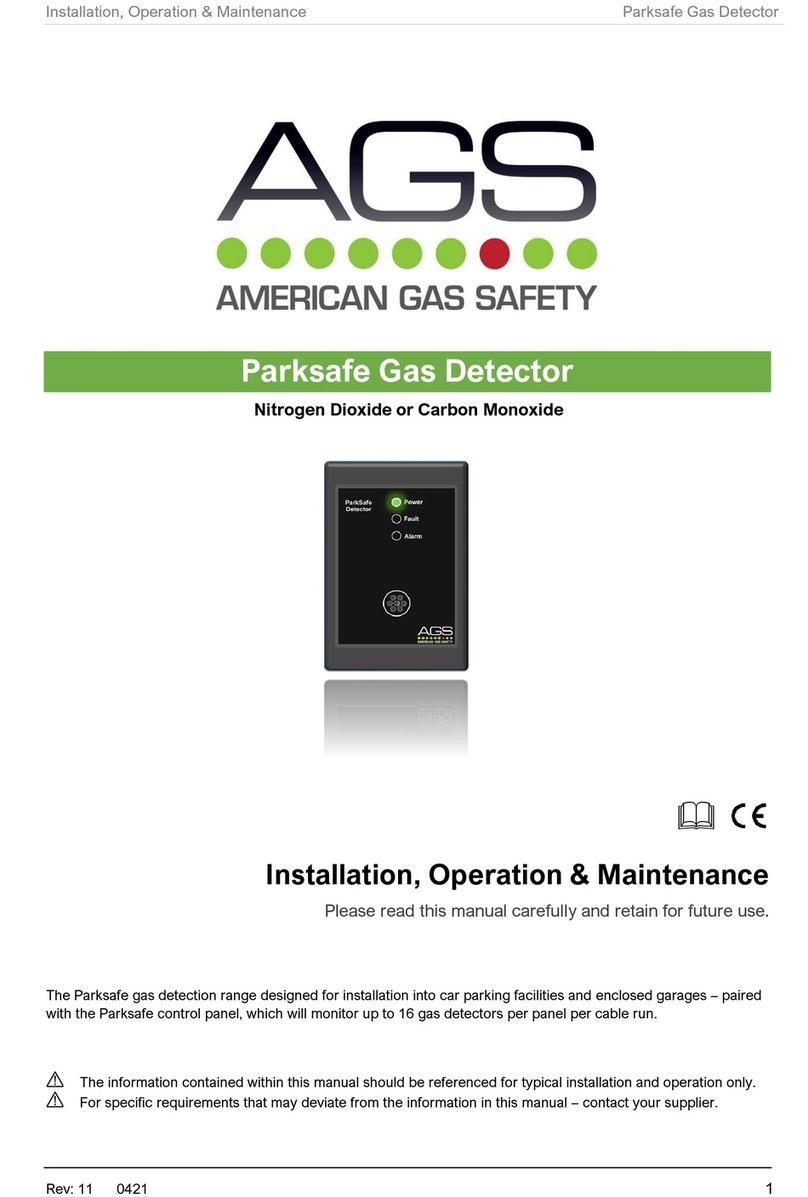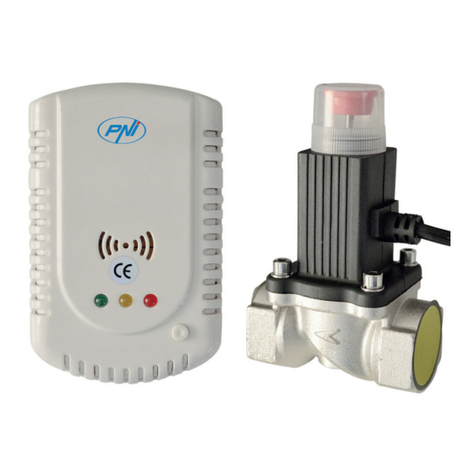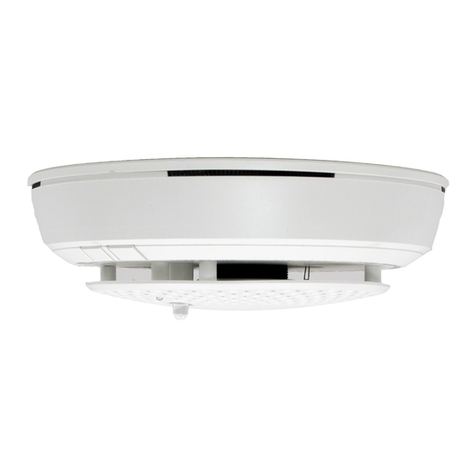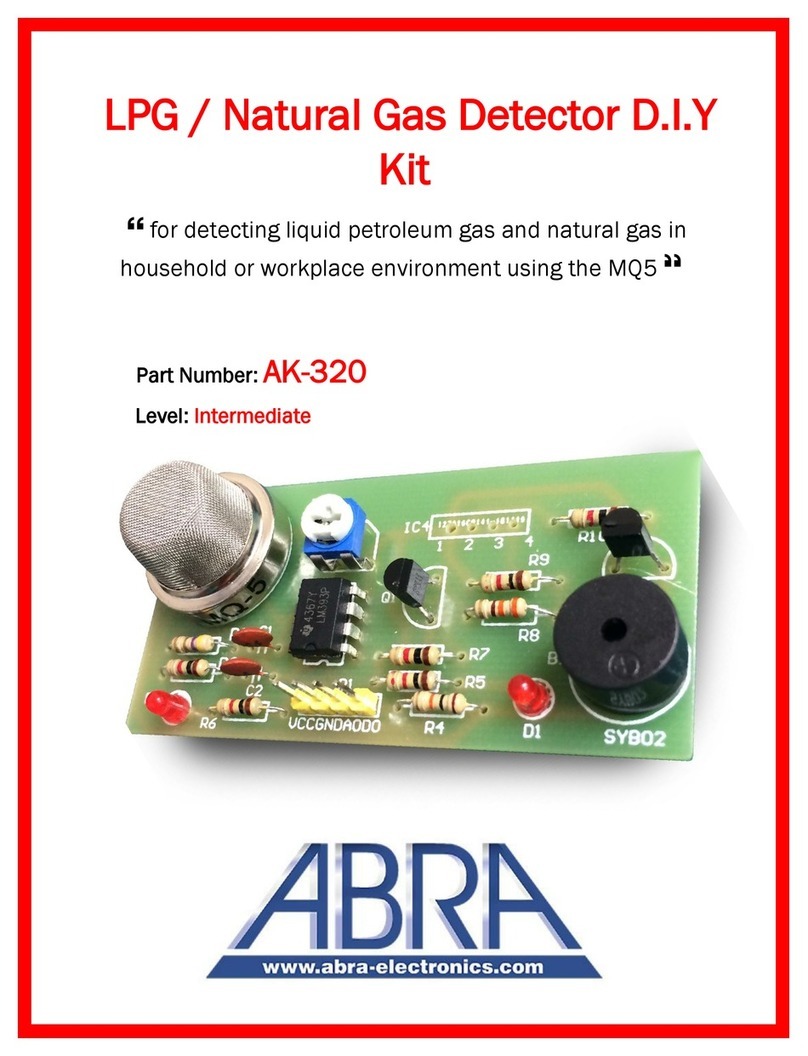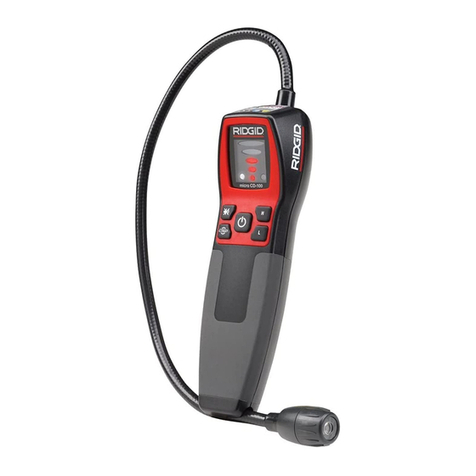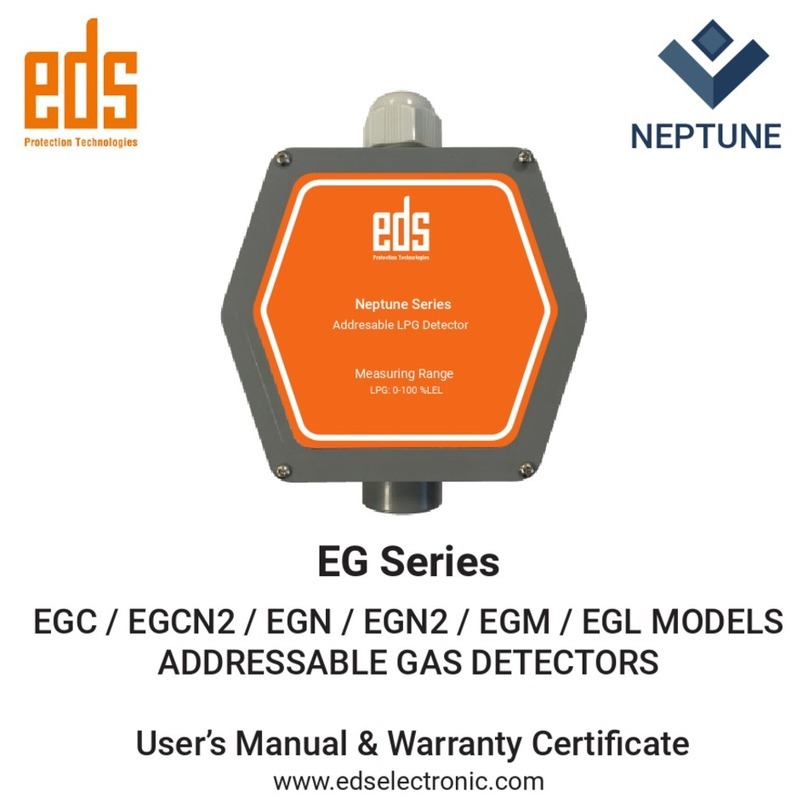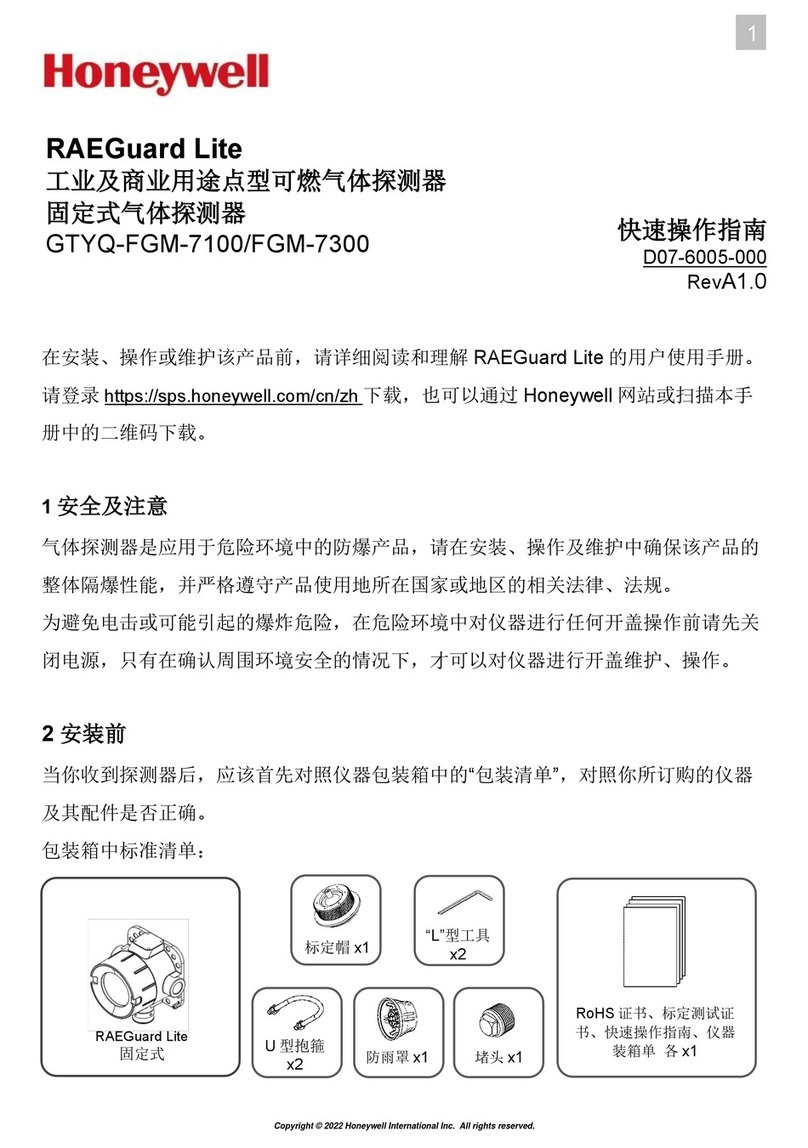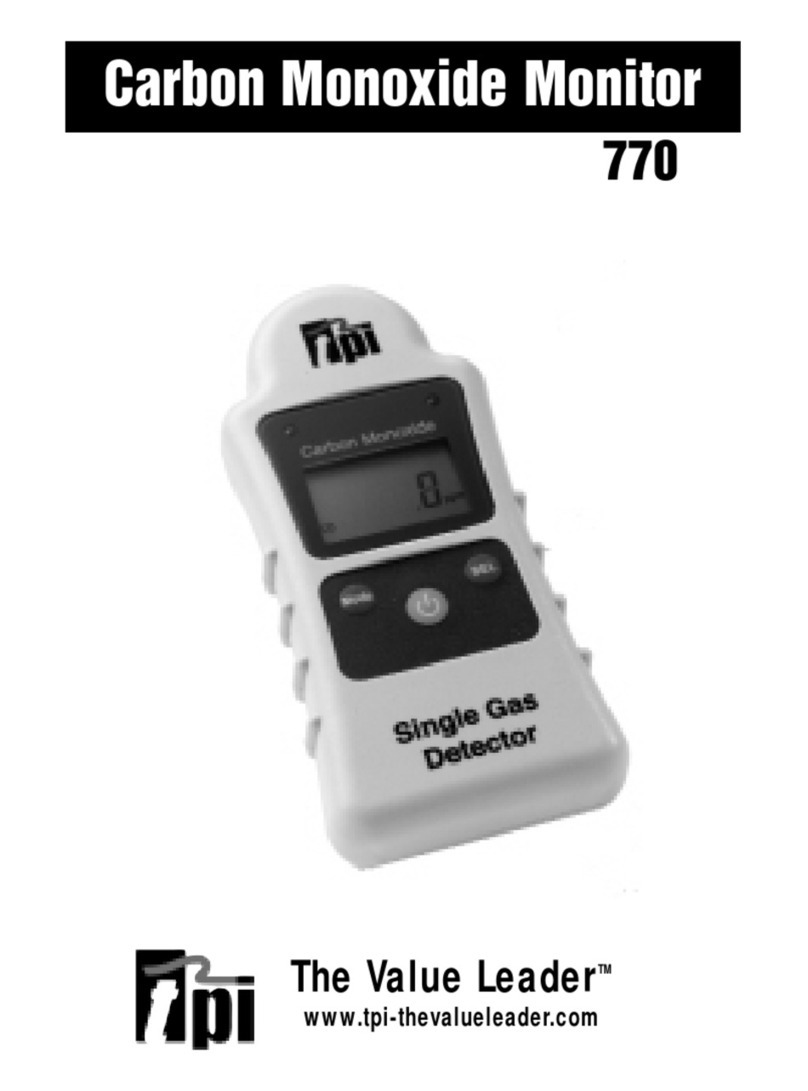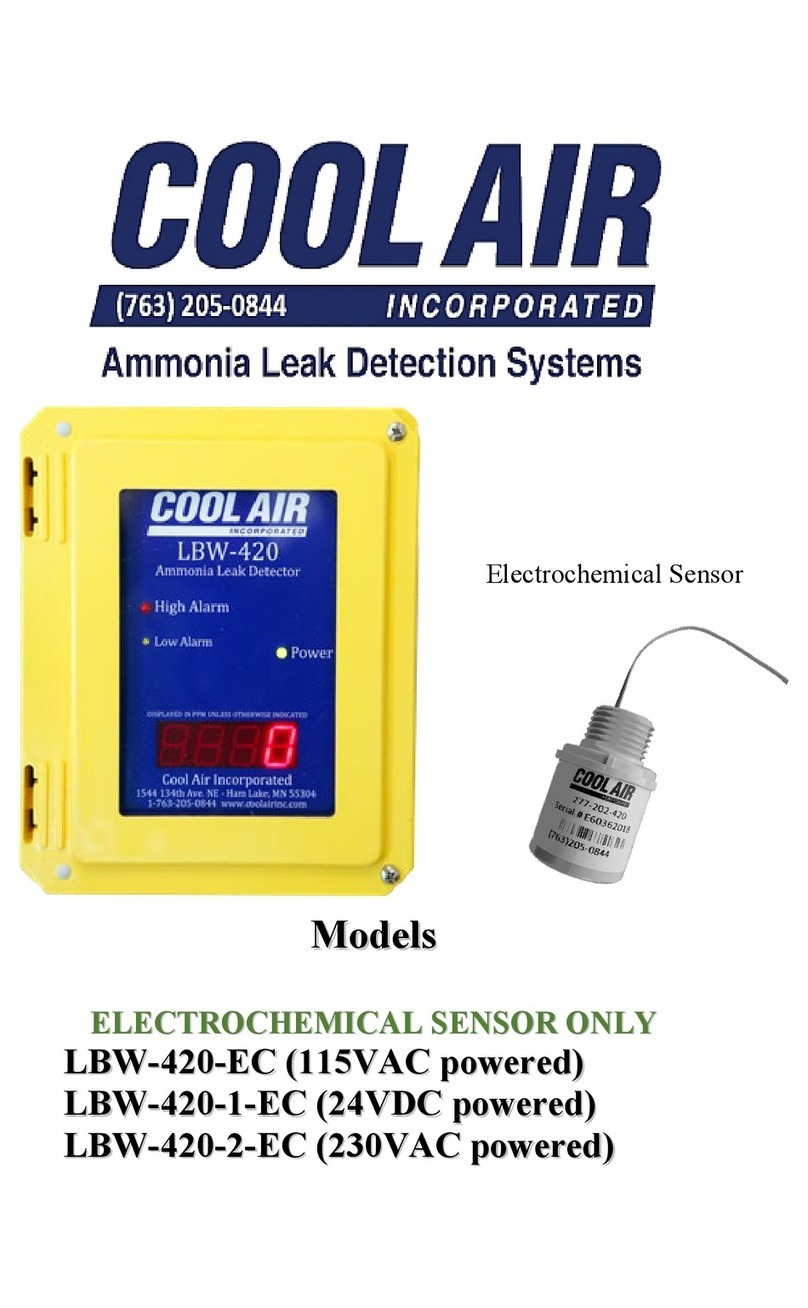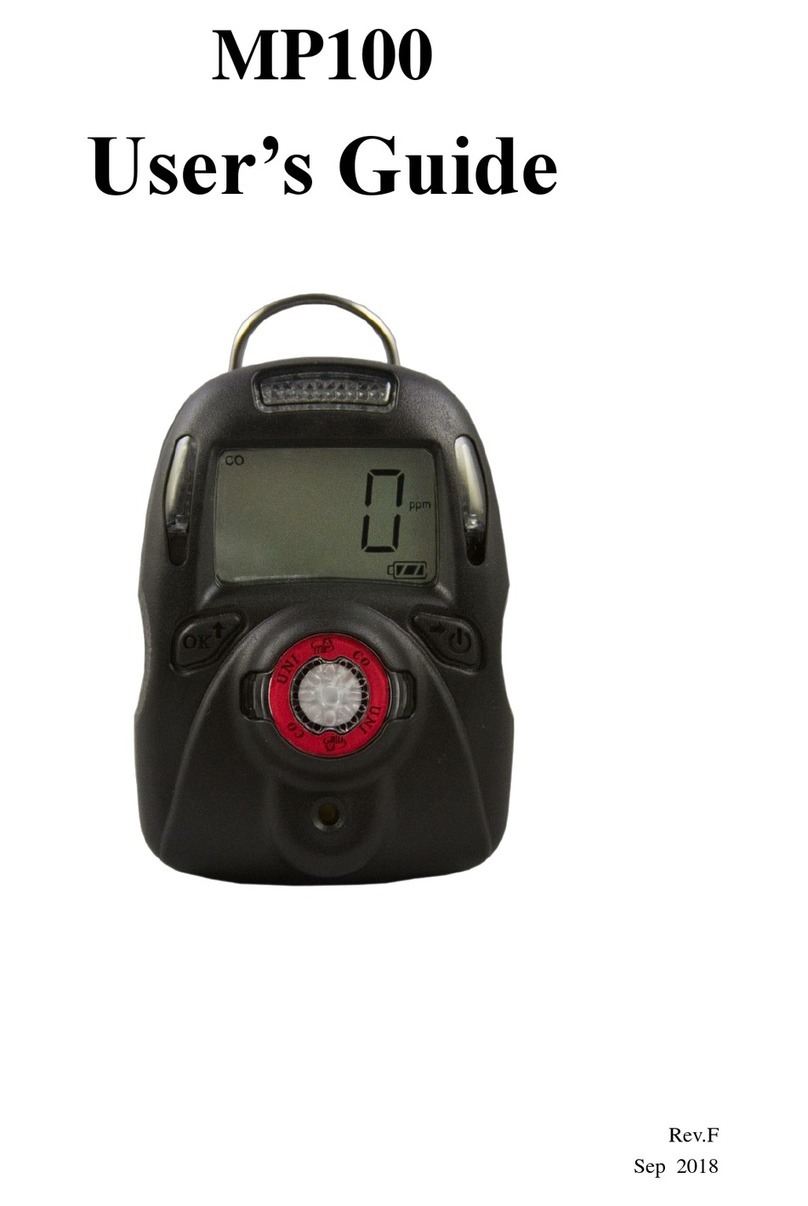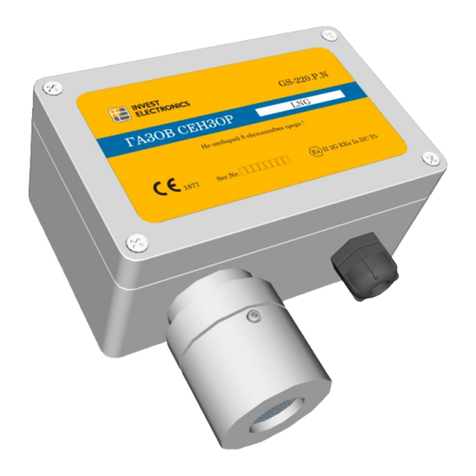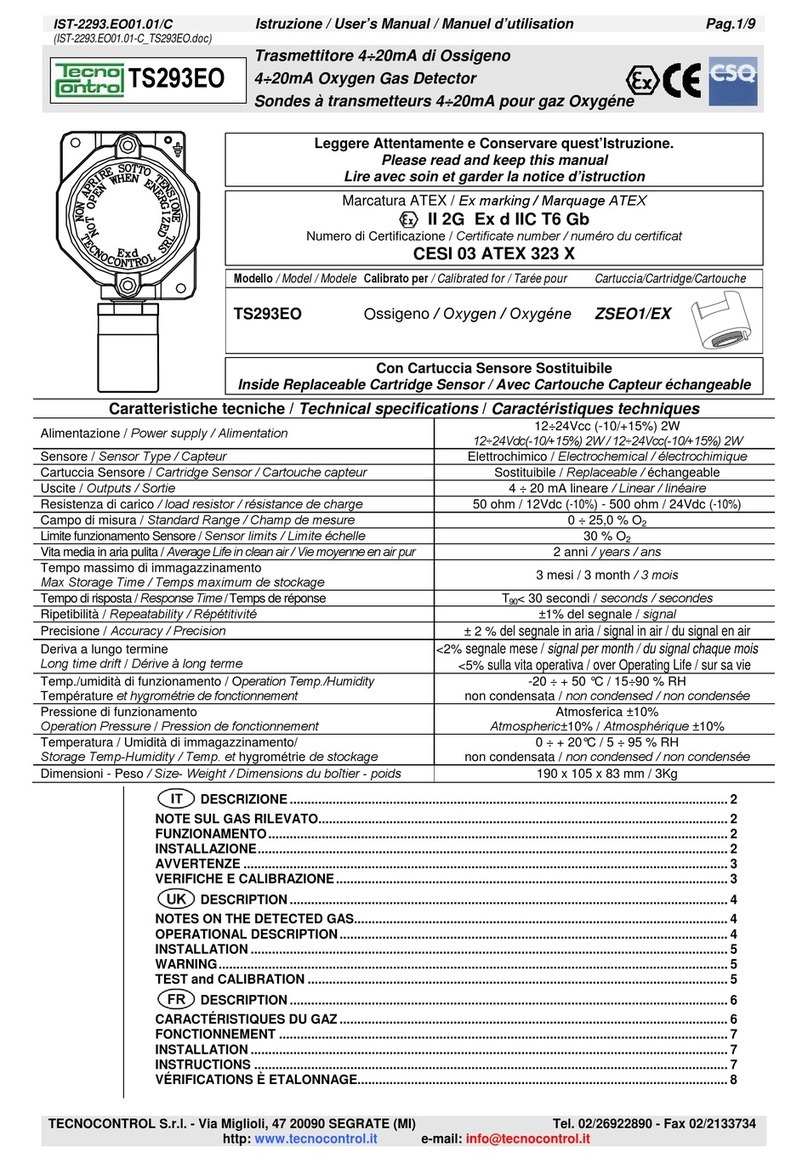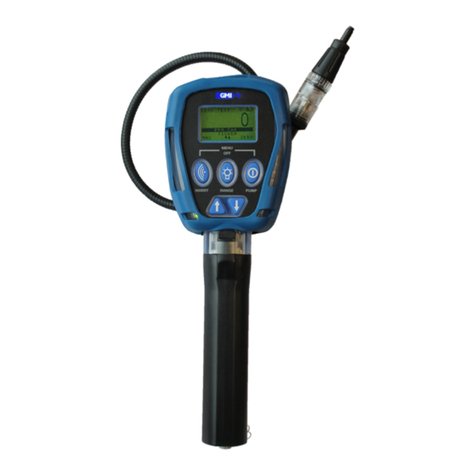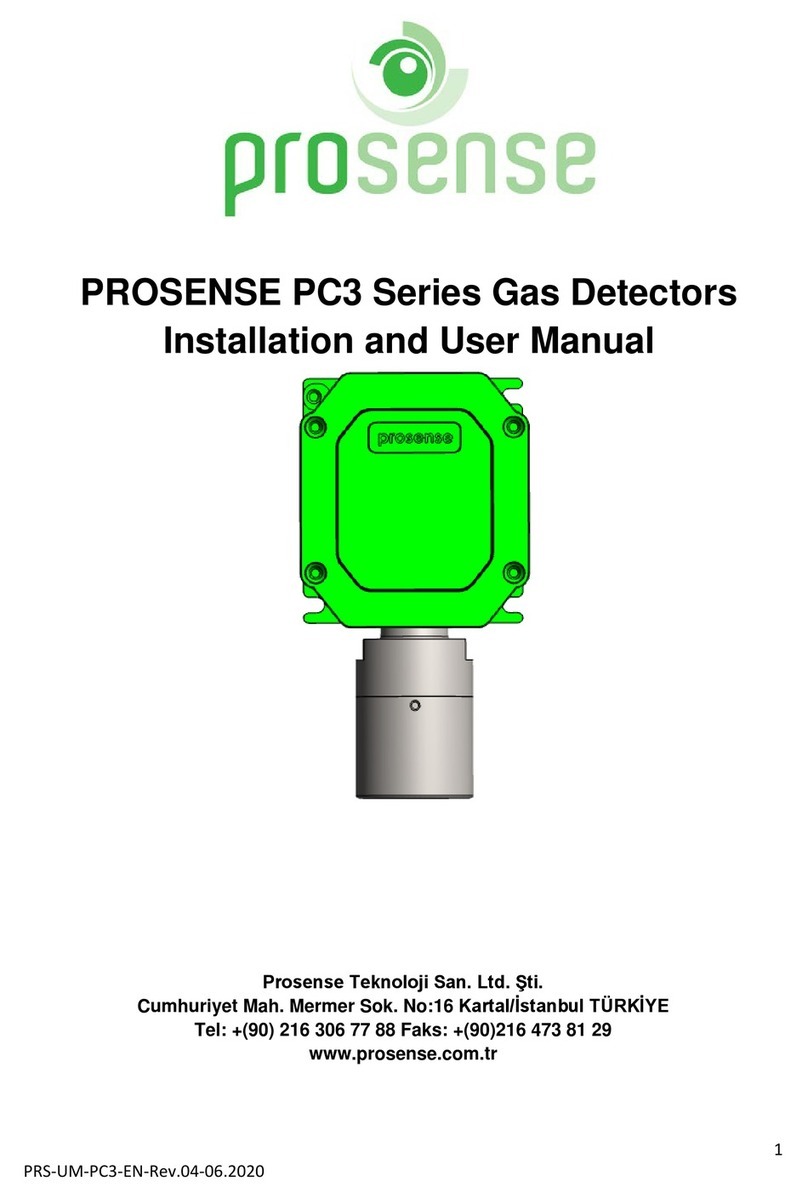Jesco GW 601 User manual

GW 601
Gas Warning Device for Chlorine Gas, Chlorine Dioxide and Ozone
Operating instructions
Read this operating manual before using the equipment.
To be retained for future reference.
EN 02
Dosing
Conveying
Control
Liquids
Gases
Systems

2 | Operating Manual GW 601 | Table of Contents
Table of Contents
1. General and safety instructions ................................................................................................................................3
1.1 General............................................................................................................................................................. 3
1.2 Identification of safety instructions in the operating manual ................................................................................. 3
1.3 Personnel qualifications and training .................................................................................................................. 3
1.4 Important safety instructions .............................................................................................................................. 3
1.5 Hazards due to non-compliance with the safety instructions ................................................................................ 4
1.6 Safe operation................................................................................................................................................... 4
1.7 Safety instructions for the operating company/operator........................................................................................ 4
1.8 Safety instructions for inspection, maintenance and installation work.................................................................... 4
1.9 Unauthorised modification and production of spare parts ..................................................................................... 4
2. Before using the equipment......................................................................................................................................5
2.1 Proper intended use .......................................................................................................................................... 5
2.2. Scope of delivery .............................................................................................................................................. 5
2.3 Start-up procedure ............................................................................................................................................ 5
2.4 Part numbers .................................................................................................................................................... 5
3. Functional range........................................................................................................................................................6
3.1 Measurement amplifier GW 601......................................................................................................................... 6
3.2 Transmitter........................................................................................................................................................ 6
3.3 Power supply backup system (accessory)............................................................................................................ 6
4. Dimensioned drawings..............................................................................................................................................7
5. Technical data............................................................................................................................................................8
6. Assembly and installation.......................................................................................................................................11
6.1 Measurement amplifier GW 601....................................................................................................................... 11
6.2 Transmitter...................................................................................................................................................... 12
6.3 Connection...................................................................................................................................................... 12
6.4 Drill template................................................................................................................................................... 14
7. Operation..................................................................................................................................................................15
8. Configuration ...........................................................................................................................................................16
9. Operation..................................................................................................................................................................17
10. Relays.....................................................................................................................................................................19
10.1 Measures in case of Alarm or Malfunction....................................................................................................... 19
10.2 Configuration................................................................................................................................................. 19
11 Analogue Output and Interface ..............................................................................................................................20
11.1 Analogue output ............................................................................................................................................ 20
11.2 Interface ....................................................................................................................................................... 20
12. Maintenance ..........................................................................................................................................................21
12.1 Changing the sensor...................................................................................................................................... 21
12.2 Functional check ........................................................................................................................................... 22
12.3 Adjusting the changeover pressure ................................................................................................................. 22
12.4 Replace the fuse............................................................................................................................................ 22
12.5 Power supply backup system (accessory)........................................................................................................ 22
12.6 Disposal........................................................................................................................................................ 22
13. Troubleshooting .....................................................................................................................................................23
14. Spare parts.............................................................................................................................................................24
Device revision ............................................................................................................................................................24
Index.............................................................................................................................................................................25
Warranty Application...................................................................................................................................................26
CE Declaration of conformity ......................................................................................................................................27

Safety notices | Operating Manual GW 601 | 3
1. General and safety instructions
1.1 General
This operating manual contains basic instructions to be followed during installation, operation and
maintenance. It is therefore essential that the Operating Manual be read by the installation technician
before installing and commissioning the pump/system, as well as by the relevant operating personnel/
operating company of the unit. The Operating Manual must remain accessible at the dosing pump/system
for reference at all times. Besides the general safety instructions in this "Safety" section, the special safety
instructions in the other sections are also to be followed.
1.2 Identification of safety instructions in the operating manual
This operating manual contains essential safety instructions. Failure to observe this information may endan-
ger other people and the unit. The safety instructions are identified by the following symbols:
WARNING!
Refers to a potentially hazardous situation. Failure to follow this instruction may lead to death or severe
injury.
CAUTION!
Refers to a potentially hazardous situation. Failure to follow this instruction may lead to minor injury or
damage to property.
ATTENTION! or NOTICE!
Failure to comply with this safety instruction may result in damage to the device and endanger its operation.
IMPORTANT!
This refers to additional information to facilitate operation and ensure the smooth running of the equipment.
Notices attached directly to the unit, such as wire references, must be observed and kept in a fully legible
condition.
1.3 Personnel qualifications and training
The personnel employed for operation, maintenance, inspection, and installation must be suitably qualified
for this work. The responsibilities, areas of competence and personnel supervision must be clearly defined
by the operating company. Personnel who do not have the required know-how must be duly trained and
instructed. If necessary, this can also be done by the manufacturer/supplier on behalf of the operating
company. In addition, the operating company must also ensure that the relevant personnel are fully familiar
with and have understood the contents of the operating manual.
1.4 Important safety instructions
Basic safety precautions should always be followed when installing and using this electrical equipment.
These include the following:
READ AND FOLLOW ALL INSTRUCTIONS!
WARNING!
To reduce the risk of injury, do not permit children to use this product unless they are closely supervised at
all times.
WARNING!
Risk of electric shock. Connect the device only to a SCHUKO socket outlet protected by a ground fault circuit
interrupter (GFCI). Contact a qualified electrician if you cannot verify that the connector is protected by a
GFCI.
Do not bury cord. Secure the cable to avoid damage by lawn mowers, hedge trimmers and other equipment.
WARNING!
To reduce the risk of electric shock, replace the cable immediately if damaged.

4 | Operating Manual GW 601 | Safety notices
WARNING!
To reduce the risk of electric shock, do not use an extension cable to connect the device to the power
supply; use an appropriately located socket.
KEEP THESE INSTRUCTIONS IN A SAFE PLACE!
1.5 Hazards due to non-compliance with the safety instructions
Failure to comply with the safety instructions may endanger not only people, but also the environment and
the unit. Failure to follow the safety instructions may invalidate any damage claims.
The following hazards in particular may result:
• Failure of major unit und system functions.
• Danger to persons due to electrical, mechanical and chemical effects.
1.6 Safe operation
The safety instructions contained in this operating manual must be observed. The operating company is
responsible for ensuring compliance with local safety regulations. Any faults that could affect safety must be
rectified immediately.
1.7 Safety instructions for the operating company/operator
Consumables and replacement parts must be disposed of safely and in an environmentally friendly manner.
(Legal requirements must be observed).
Risks from electric current must be excluded (for further details, refer to the VDE1regulations and the
regulations of the local public utilities).
1) VDE = Association of German Electrical Engineers
1.8 Safety instructions for inspection, maintenance and installation work
The operating company must ensure that all maintenance, inspection and installation work is carried out by
authorised and duly qualified personnel, who have read and understood this operating manual.
Before carrying out installation and maintenance works, always make sure that the unit is disconnected
from power supply. The device must be prevented from being switched on again during the above work.
Only then may additional modules be mounted or removed and connections made. Non-compliance can
result in damage to the unit and invalidate the warranty. All safety and protective equipment must be
reattached and activated immediately after the work has been completed.
1.9 Unauthorised modification and production of spare parts
Modifications and conversions require prior consultation with the manufacturer. Genuine spare parts and
accessories authorised by the manufacturer ensure greater safety. No liability can be accepted for any
damage resulting from the use of non-Lutz-Jesco parts.
Use only the manufacturer's spare parts and sensors. Otherwise the warranty is invalidated.

Before using the equipment | Operating Manual GW 601 | 5
2. Before using the equipment
2.1 Proper intended use
The device is intended for the following purpose only: monitoring and displaying combustible and/or toxic
gases as well as oxygen. Operating safety is guaranteed only if the device is used for its intended purpose.
All other types of use are prohibited and will invalidate the warranty. The operating conditions described in
chapter 5 "Technical Data" must be observed!
2.2. Scope of delivery
IMPORTANT!
Carefully unpack the product and any accompanying accessories, so that no small parts are left inside the
packaging. Compare the delivery content with the delivery note immediately. If there are any discrepancies,
determine the cause.
The scope of delivery includes:
• Gas warning device GW 601
• Transmitter, including sensor
• 5 m cable
• Operating instructions
2.3 Start-up procedure
• Reading the operating manual
• Assembly and installation (section 6)
• Test (section 12)
2.4 Part numbers
Part no. Description
23600201 GW 601 gas warning device for chlorine gas
23600211 GW 601 gas warning device for chlorine dioxide, 0…1 ppm
23600212 GW 601 gas warning device for chlorine dioxide, 0…2 ppm
23600221 GW 601 gas warning device for ozone, 0…1 ppm
23600222 GW 601 gas warning device for ozone, 0…2 ppm

6 | Operating Manual GW 601 | Functional range
3. Functional range
The gas warning device is a stationary measuring, control and warning device that is in continuous opera-
tion and is used to measure toxic gases. It consists of several components that act as a single unit. It is both
reliable and easy to assemble and maintain.
The gas warning device is part of the safety system for gas conducting systems and can be used with the
following gases:
Transmitter Measuring gas
CM 601 Chlorine gas (Cl2)
DM 601 Chlorine dioxide (ClO2)
OM 601 Ozone (O3)
Table 3.1: Measuring gas, other gases on request
Chlorine gas application
The CM 601 transmitter is installed in the chlorine gas room; at a freely accessible location approx. 30 cm
above the floor. Chlorine gas is heavier than air and descends when it escapes. The sensor detects escaped
chlorine gas. The electronic system of the CM 601 transmitter records the sensor signal and converts it into
an impressed current of 4 – 20 mA which is transmitted to the GW 601 gas warning device. The 4…20
mA signal is evaluated in the gas warning system GW 601 and displayed as chlorine content in the air. If
the alarm thresholds set have been exceeded, alarm conditions are displayed or relays switched to notify
the relevant persons.
3.1 Measurement amplifier GW 601
The measurement amplifier GW 601 is the central control unit and is installed where it can be accessed by
operators. It allows measurements to be checked and alarm thresholds set.
The gas warning system receives the 4…20 mA signal from the transmitter and evaluates it. The digital
display shows the gas content of the air in the monitored room.
The gas warning system can be configured without the transmitter being attached.
3.2 Transmitter
The transmitter consist of
• a sensor block (sensor and sensor guard)
• an evaluation and amplification electronic system (sensor board)
It has a robust and corrosion-proof housing for industrial applications.
The sensor is an electronic measuring cell that works according to the electro-chemical principle. The
sensor block in the transmitter is easy to replace.
The transmitter allows for monitoring, calibration and adjustment. The sensor board converts the sensor
signal into a 4 … 20 mA analog signal. The connecting cable supplies power to the sensor circuit board
and transmission of the measurements.
3.3 Power supply backup system (accessory)
The backup system is a uninterruptible power supply (battery) that feeds the gas warning device system in
the event of a power failure. This supply will keep the device working for approximately 10 hours.

Dimensioned drawings | Operating Manual GW 601 | 7
4. Dimensioned drawings
90 mm 160 mm
146 mm
160 mm
194 mm
146 mm
Fig. 4.1: Gas warning device GW 601
105 mm
65 mm
138 mm
Fig. 4.2: Transmitter
380
380
210
Fig. 4.3: Power supply backup system (accessory)

8 | Operating Manual GW 601 | Technical data
5. Technical data
Gas warning device GW 601
Voltage supply 230 V AC 50 Hz
Power consumption max. 18 W
Internal fuse F 160 mA, 5 x 20 mm
Display LCD display:
• 4 x 20 characters, lit
• Displays measurements, messages and alarms
• Bar chart to display measuring gas concentration
• Menu language German and English
LED:
• Red for alarm 1
• Red for alarm 2
• Green for operation
• Orange for fault
Controls Keypad with 4 keys
Relays 4 changeover contacts, 250 V AC, 5 A, potential-free, programmable
self-locking
Max. 550 VA ohmic resistive load (with RC protective circuit, suppression
element)
• Alarm 1
• Alarm 2
• Fault
• Horn
Analogue output 4…20 mA, max. working resistance 500 Ω
Corresponds to the measuring signal from the transmitter provided it lies
within the 1.5…22.5 mA range.
No. of transmitters max. 1
Alarm thresholds 2 limits, pre-configured, freely adjustable
Chlorine (Cl2) Chlorine dioxide (Cl2) Ozone (O3)
Limit value 1 2 ppm 0.2 ppm 0.2 ppm
Limit value 2 10 ppm 1 ppm 1 ppm
Digital input -
Interface RS 232 / RS 485
Signal generator Internal horn
Additional functions Alarm blocking in service mode
Dimensions (W x H x D) 160 x 194 x 90 mm
Installation Wall assembly
Housing material ABS
Protection class IP 54
Weight ~ 1.0 kg
Cable entry point PG connections
1x M20 x 1.5 (cable diameter 7…13 mm)
5x M16 x 1.5 (cable diameter 5…10 mm)
Connections Screw-type terminals for cables up to maximum 1.5 mm2
Ambient temperature -10 … +40 °C

Technical data | Operating Manual GW 601 | 9
Storage temperature -25 … +60 °C
Air humidity 15…90 % rH, non-condensing
Transmitter
Measuring gas Chlorine (Cl2) Chlorine dioxide (Cl2) Ozone (O3)
Measuring range 0 ... 10 ppm 0 ... 1 ppm
or 0…2 ppm
0 ... 1 ppm
or 0…2 ppm
Measuring principle Electro-chemical cell. Two or more electrodes arranged in an electrolyte.
An electro-chemical reaction takes place at the electrode. It generates
an electrical current which is proportional to the concentration in the
measuring gas.
Power-up phase 60 s constant current of 0.8 mA
Reaction time approx. 30 s
Stabilisation time 60 min (90%), 24 h (99%)
Supply voltage 24 ± 6 V DC
Power consumption 40 mA / 1 W
Measuring signal 4 … 20 mA, linear, max. working resistance 500 Ω
4 mA = zero point, 20 mA = measuring range limit
Dimensions (H x W x D) 126 x 82 x 60 mm
Housing material Cast aluminium (painted) / PTFE, high frequency shielded
Protection class IP 54 (except for gas inlet)
Weight approx. 0.5 kg
Cable entry point M16 x 1.5 (Cable diameter 59 mm)
Cable 3-wire, 0.8 mm2, shielded, core resistance 18 Ω, max. 1000 m
Ambient temperature -10 … +45 °C
Storage temperature -20 … +45 °C
Air humidity 15…90 % rH, non-condensing
Air pressure 900 ... 1100 hPa
Service life 2 years, depending on the operating conditions
Self-monitoring If an error is detected during the automatic checks, the output current
is set to 1.1 mA. The yellow LED indicates a fault on the GW 601 gas
warning device.
IMPORTANT!
Avoid prolonged operation in dry atmospheres. Permanent exposure to H2S will damage the sensor.

10 | Operating Manual GW 601 | Technical data
Power supply backup system (accessory)
Override time Max. 10 h
Changeover time 2…6 ms
Voltage supply 220 / 230 / 240 V AC, 50/60 Hz
Mains output supply 230 V AC ±10%, 50/60 ±1 Hz
Output rated current 2.2 A
Protection • Overload
• Full discharge
• Short circuit
• Excess temperature
Charge time 8 h
Battery 12 V DC, 7 Ah, maintenance-free, 3…5 years service life
Interface USB, RS 232
Ambient temperature 0 … 45 °C
Storage temperature 0 … 45 °C
Air humidity 0…90 % rH, non-condensing
Housing Steel sheet, powder-coated, lockable
Dimensions (W x H x D) 380 x 380 x 210 mm
Protection class IP 66
Weight approx. 18 kg

Assembly and installation | Operating Manual GW 601 | 11
6. Assembly and installation
ATTENTION!
Electrical connections must only be performed by specialist personnel in accordance with relevant installa-
tion requirements.
ATTENTION!
Make sure the device is de-energised when working on it. The power supply must only be switched on after
assembly and electrical connections have been completed.
IMPORTANT!
Note the power supply specified on the rating plate.
IMPORTANT!
Where possible, a continuous cable from sensor to the measuring input should be used. An extension of
the cable by plugs or terminal sockets increases the risk of faults caused by contamination, humidity or
excessive transition resistances.
ATTENTION!
Input, output and control lines and cables must always be kept separate. In particular, they must be routed
away from power circuit lines!
NOTE!
All cables must be routed to protect them from mechanical damage. Strain relief must be provided near the
cable entry point.
Stray interference will falsify the measurement. Power supply and measuring lines at close proximity should
only cross at a 90° angle. The permissible length of the measuring cables must be adhered to with regard
to the sensor used. When measuring ensure that the (plug) connections are clean and dry and that the lines
do not become brittle due to sharp buckling. The shielded cables normally used for such measuring lines
must be of the quality specified.
6.1 Measurement amplifier GW 601
The electrical installation for the gas warning device must contain a separating device (e.g. an automatic
circuit breaker) to ensure reliable separation from the power supply.
The device is designed for a fixed installation connected to a power supply of 230 V /AC. The device
corresponds to protection class I in accordance with EN 60335 and must be connected to a protective earth
conductor (PE).
When connecting to the relays, note that inductive loads must be dejammed. If this is not possible, the strip
relay contact on the device terminal must be protected by an RC protective circuit / suppression element.
For DC voltage the relays or contactor coil must be dejammed with a freewheeling diode.
RC protective circuit / suppression element
Current Capacitor C Resistor R
< 60 mA 10 nF 260 V 390 Ohm 2 Watt
< 70 mA 47 nF 260 V 22 Ohm 2 Watt
< 150 mA 100 nF 260 V 47 Ohm 2 Watt
< 1 A 220 nF 260 V 47 Ohm 2 Watt

12 | Operating Manual GW 601 | Assembly and installation
ATTENTION!
The assembly location must be selected so that the device is not subject to any mechanical load or chemi-
cal exposure in any way.
When assembling make sure there is clear access to the device.
6.2 Transmitter
• A transmitter can be connected to the GW 601 gas warning device.
• The transmitter is connected via a shielded 3-wire cable.
• All input and output wires and cables must be shielded. The shielding must be applied on one side
only.
• The gas inlet of the sensor must be kept clear of dust and contamination.
• Wall assembly is with the sensor opening facing down, close to the ground (approx. 30 cm high) with
two screws (max. Ø 4 mm) and only with the cover open.
• During assembly make sure that the transmitter is accessible for maintenance work.
• Keep a minimum distance of 10 cm between the sensor opening and other fixtures.
The cables pass through the PG connections into the housing interior. The cable entry point consists of the
flange which screws into and is sealed in the basic housing, the clamp/seal assembly and the threaded
sleeve. Insert the cable in turn through the threaded sleeve, clamp/seal assembly and the flange. Make sure
the clamp/seal assembly is correctly installed. Fasten the cable by screwing the threaded sleeve tightly.
Note
The cable shielding must not be introduced into the transmitter. The grounding terminal in the housing
should not be occupied.
All transmitter terminals are plug-in terminals. Remove the connectors before routing the cables to avoid
mechanical damage. Do not plug them back in until you have completed the assembly.
6.3 Connection
N PEL L N PE
Alarm 1 Fault
Alarm 2
SHLD
GND
I in
+24 V
I out-
I out+
485A
485B
Fuse 5x20
Horn
1 2 3
GND
+24 V
DIN1+
DIN1-
DIN2+
DIN2.
485A
485B
1 2 3 1 2 3
1 2 3 1 2 3
①
RS 232

Assembly and installation | Operating Manual GW 601 | 13
Terminal Connection Note
Alarm 1 Relay 1 Relay outputs
Alarm 2 Relay 2
Fault Relay 3 for fault
Horn Relay 4 for signal generator
L / N / PE 230 V AC Voltage supply
Fuse Internal fuse
SHLD Shielding a Connection to transmitter
GND Ground
I in Input 4 to 20 mA
+24V Output 24 V DC
I out - - 4…20 mA output
I out + +
485A A (-) RS 485 interface
485B B (+)
Fig. 6.1: GW 601 gas warning system wiring diagram, aConnection to transmitter
U+
GND
SENS
ZERO
mA
LED (GN)
LED (RD)
GWZ 601
Terminal Function Connection Note
mA Output 4 to 20 mA Connection to the gas warning device GW 601
GND Ground
U+ Input 24 V DC
SENS Calibration potentiometer, see chapter 12.1
ZERO
LED (GN) Fault analysis LED, see chapter 13
LED (RD)
Fig. 6.2: Transmitter wiring diagram

14 | Operating Manual GW 601 | Assembly and installation
6.4 Drill template
Width x height
Gas warning device GW 601 146 x 146 mm
Transmitter 52 x 113 ... 116 mm

Operation | Operating Manual GW 601 | 15
7. Operation
Controls
aAlarm 1 LED (red)
bAlarm 2 LED (red)
cOperation LED (green)
dFault LED (orange)
e4 function keys F1, F2, F3, F4 or
selection keys ◀, ▲, ▼, ▶
fLCD display
The selection keys have a repeat function which allows you to automatically repeat the key function when
held down for a long period. The functions of F1 to F4 differ depending on the operating mode. They are
shown in the bottom line of the graphic display.
Cl2 0.0 ppm
<
A1= 0.8 A2= 1.0
NEXT QUIT HORN
F1
◀
F2
▲
F3
▼
F4
▶
Fig. 7.2: GW 601 display, standard
1. line: Measuring gas or size, current measurement with unit.
2. line: Bar chart presentation of the measurement, 0 to 100%.
3. line: Threshold settings for alarms 1 and 2.
4. line: Assignment of the function keys F1 to F4.
Function keys
Key Normal mode Activation / service mode
F1 Jump to menu (NEXT)
F2 Acknowledge alarms ▲and ▼, modify figures / scroll through selection
F3 Not assigned
F4 Confirm entry
b
a
cd
e
f

16 | Operating Manual GW 601 | Configuration
8. Configuration
IMPORTANT!
Measurement processing continues unchanged during configuration.
The configuration menu runs in a continuous loop. Press function key F1 repeatedly until the desired menu
is displayed.
All settings can be viewed but not changed in normal mode. Settings can only be changed in activation /
service mode. This can only be achieved by entering a password / key combination.
The changes are only activated once the menu has been exited. If you exit the menu without pressing F4
(SAVE), the most recent settings remain intact.
If no input is made for more than 10 minutes, the GW 601 reacts differently, depending on the operating
mode:
• Normal mode: Changes to standard display
• Release: Changes to standard display and normal mode.
• Service operation: no change.
The GW 601 gas warning system contains all the parameter settings needed to adapt the device to the
requirements of the application.
IMPORTANT!
In order to make changes, the system must be activated by entering a password / key combination.
Menu Selection Function
Password ——
(Normal mode)
OK
(Activation)
automatic, F1 (NEXT) key for next menu.
Release: Press F3 and F4 simultaneously for approx. 5 seconds.
Keep pressing this key combination for approximately five seconds to
disable activation.
GB
D
After activation, press F2 to switch between German (D) and English
(GB).
GB: German is active, change to English with F2
D: English is active, change to German with F2
Services OFF
ON
In service mode alarm and fault messages are blocked, the relay
outputs are inhibited and the operation LED flashes.
Gas List of gases Select measuring gas
Dimension ppm, vol.-%,%
UEG, pH, degree
Unit for the measuring range. The unit chosen will be displayed during
normal operating mode.
Decimal
point
0
0.0
Shown with or without a decimal point for measurement display,
measuring range limit and alarm limits.
Range 10.0 Sets the measuring range limit between 0…30000
Alarm 1,
alarm 2
0 to the measur-
ing range limit
Sets the two alarm thresholds and the direction of the overrun to
trigger the alarm. The alarm threshold limits are arranged in ascending
order. The alarms are triggered when the limit is exceeded.
Quit A1,
Quit A2
ON
OFF
Indicates whether the alarm and the corresponding relay are self-lock-
ing (ON) or non-locking (OFF). A non-locking alarm goes out when
the alarm condition no longer applies (check the alarm hysteresis). A
self-locking alarm must always be reset via manual acknowledgement,
by using the F2 (QUIT) function key.

| Operating Manual GW 601 | 17
Horn A1 A2 Indicates whether the horn relay (and the integrated signal generator
linked to it) has been assigned to alarm 1 or alarm 2. Both alarms are
deactivated for a "---" setting. The horn relay can be acknowledged
with the F3 (HORN) function key even if the alarm condition is still
present.
ATTENTION!
The horn relay should only be used for external acoustic signal
generators.
NOTE!
The horn is triggered again if the alarm threshold is again exceeded
after a subsequent interruption (new event alarm). This also applies if
a self-locking alarm has not been acknowledged in the meantime.
Relay
mode A1,
A2, F, H
Closed, Opened Indicates whether the alarm, fault or relay drops out or applies when
the trigger condition is met.
Opened: The relay is applied during measuring mode and drops out
when the alarm limit is exceeded.
Closed: The relay has dropped out during measuring mode and closes
when the alarm limit is exceeded.
NOTE!
For the "Opened" setting an interruption in the power supply to
the warning device has the same effect as triggering an alarm or a
message.
Hyst. 0% to 10% Sets the alarm hysteresis as a percentage of the value of the corre-
sponding alarm threshold. A non-locking alarm only goes out if it is
below the alarm threshold by less than the value of the hysteresis or
2% of the measuring range limit. The larger value applies. This pre-
vents the alarm from being repeatedly triggered as a result of minor
measurement fluctuations around the alarm limit.
NPC 0 to 5% A near point of convergence can be set. The range of values ± NPC
over the measuring range limit is displayed as zero. The adjacent
range of up to ± 2 NPC from the measuring range limit will show a
flowing convergence to a linear steady state characteristic. Default
setting: 0%, i.e. deactivated.
ACTUAL: The current, unconverted value of the transmitter output
current at the input of the gas warning device is displayed.
ATTENTION!
The following adjustment to the GW 601 gas warning system without a transmitter must only be per-
formed by trained personnel.
Zero Zero point position. No correction is made for a value of 4,000 mA.
ACTUAL: The measurement corrected around ZERO and possibly GAIN is displayed.
Gain Amplification correction value. No correction is made for a value of 1,000.
ACTUAL VALUE: The corrected measurement around ZERO and possibly GAIN is displayed.
Adjustment takes place in two stages:
1. If no gas is supplied the zero point is initially changed until the ACTUAL VALUE shown in the display
is 0. Note that negative values are represented by "< 0". In case of a correct adjustment, the
preceding "<" disappears and precisely "0" is displayed.
2. Subsequently, when a test gas is supplied, GAIN is adjusted until the actual value shown in the
display corresponds to the setpoint.

18 | Operating Manual GW 601 | Operation
9. Operation
Operating states of the measurement amplifier GW 601.
Power-up phase
The connected transmitter can issue undefined values to the gas warning device GW 601 immediately after
the system has started up. This situation can lead to false alarms. All alarm messages are therefore blocked
for 120 seconds after the system has been switched on, or after the power supply has been interrupted.
The LEDs begin to blink as soon as power is switched on, and the time remaining until normal operations
are resumed is indicated by a decrementing counter. The entire memory is completely tested. This test is
subsequently repeated at regular intervals in measuring mode.
After the start-up pause of 120 seconds, the green "Operating" LED burns continuously and the gas warn-
ing device is in Detection mode.
Data logging
Automatic data logging is indicated by the continuously lit green "Operation/Power" LED. Signals from the
transmitter are now recorded by the GW 601 gas warning device.
Service mode
In service mode, alarm and fault signals are blocked. Service mode is indicated by the flashing operation
LED. Service mode can be activated in the configuration menu.
In service mode activation is permanently enabled.
"Alarm"
Two alarm thresholds can be set, limit value 1 and limit value 2. The red LED Alarm 1 or Alarm 2 illuminates
if the alarm threshold has been exceeded.
If there is a fault on the GW 601 or the transmitter, the yellow LED lights up.
Power-up phase Data logging Service
mode Alarm
Alarm LED
Alarm 1, 2 Red
Flashing
Off On *)
Fault Yellow On **)
Operation/
Power
Green On Flashing On
Display
Measurement
No display Current measurement
Bar display
A1, A2 limits Current settings
Relays
Alarms 1 and 2
No relay switched
Not activated
No relay
switched
Activated *)
Fault Activated Not activated **)
Horn Not activated Activated *)
Integrated signal generator
*) LEDs and relays switch according to the limit exceeded
**) LEDs and relay switch if there is a fault with the GW 601 gas warning device or transmitter.

Relays | Operating Manual GW 601 | 19
10. Relays
Four relays are used to control external devices or forward information.
• Two limits / alarm thresholds can be set up.
• "Alarm 1" relay is switched when limit 1 is reached. This is not self-locking and returns when the level
falls below limit 1 again.
• "Alarm 2" and "Horn" relays are switched when limit 2 is reached. They are self-locking and do not
return when the level falls below limit 2 again.
• The "Fault" relay switches if there is a fault with the GW 601 gas warning device or transmitter.
The limits are pre-set depending on the model, see table 8.1. Adjustments can be made in the Alarm 1 /
Alarm 2 menu.
Limit Value Chlorine gas Chlorine dioxide Ozone
1 2 ppm 0.2 ppm 0.2 ppm
2 10 ppm 1 ppm 1 ppm
Tab 10.1: Preset limit values per measuring gas
Relays Limit Value Delay Self-
locking
Acknowledgement Use
Alarm 1 1 No delay No Can be manually acknowl-
edged immediately
Optical signal generator
Alarm 2 2 Yes Can only be acknowledged
manually when the level
falls below limit 2.
Sprinkler with acknowl-
edgement via door
contact.
Horn Can be manually acknowl-
edged immediately
Acoustic signal
generator
Tab. 10.2: GW 702 measurement amplifier relays
Example
If "Alarm 2" relay activates the sprinkler, and a door contact is connected to the digital input, then in event
of an alarm the sprinkler will be switched off as soon as the maintenance personnel enter the room. If level
2 is still exceeded when the door is closed, the "Alarm 2" relay switches again.
10.1 Measures in case of Alarm or Malfunction
Limit value 1
When limit value 1 is exceeded there is a minimum gas concentration present. Appropriate action must be
taken immediately.
CAUTION!
Repair work may only be started when the concentration has dropped below limit value 1.
Limit value 2
When limit value 1 is exceeded the endangered area and all surrounding rooms must be evacuated. The
actions listed in the health and safety regulations and chlorine alarm plans must be taken.
10.2 Configuration
Direction
The relays in the GW 601 gas warning device can work according to two different principles. They can be
adjusted in the Relay Mode menu.

20 | Operating Manual GW 601 | Relays
Operating current principle
The relay is activated when the tripping value is exceeded, i.e. the relay coils apply when the tripping value
is exceeded. If there is no power supply, exceeding the tripping value has no effect.
Delivery status for "Alarm 1", "Alarm 2" and "Horn" relays.
Standby current principle
The relay applies when there is no fault in the system. This relay returns to its original position (zero position)
when the tripping value is exceeded. Zero power supply therefore operates in the same way as exceeding
the tripping value.
Delivery status for Fault relay.
11 Analogue Output and Interface
11.1 Analogue output
You can read the measurements from the transmitter as a 4…20 mA signal via the analogue output.
The analogue output corresponds to the measuring signal from the transmitter provided it lies within the
1.5…22.5 mA range.
11.2 Interface
The devices can be optionally fitted with RS 485 and RS 232 interfaces. These are for service purposes
only.
Table of contents
